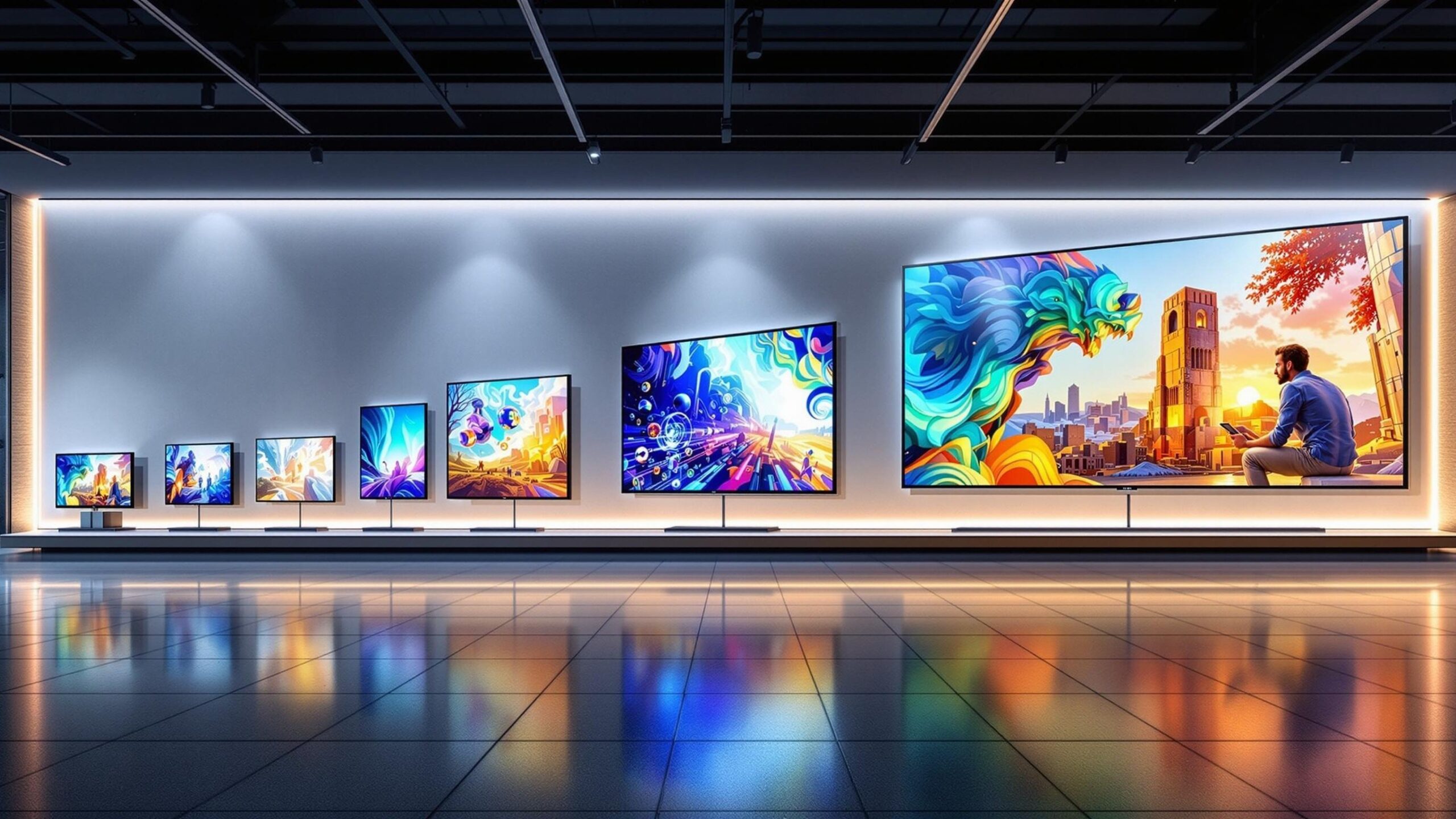TV Technology and Features: Exploring the World Behind the Screen
Television has come a long way since the bulky boxes of the mid-20th century. Today’s TVs are sleek, smart, and packed with groundbreaking technology that transforms the way we consume entertainment. From jaw-dropping visuals to immersive audio and smart connectivity, modern TV features aren’t just luxuries—they’ve become essential components of the viewing experience. This page explores the exciting world of TV technology and features, serving as a complete introduction to the innovations that define today’s home entertainment systems. Whether you’re a casual viewer or a tech enthusiast, this is your gateway to understanding everything that goes into a great television.

OLED TV’s
Welcome to the stunning world of OLED TVs, where picture quality meets pure magic. If you’ve ever dreamed of watching your favorite movies or shows with cinema-level color, infinite contrast, and razor-sharp clarity, OLED delivers on every pixel. These cutting-edge televisions bring each scene to life with breathtaking depth, true blacks, and dazzling highlights—thanks to a revolutionary technology where every pixel lights up independently. It’s not just about watching content
Display Technology: The Evolution of Picture Quality
At the heart of every television is the screen, and modern display technologies are nothing short of astonishing. The shift from cathode ray tubes to flat panels was only the beginning. Today’s displays range from LED to QLED, OLED, Mini LED, and MicroLED—each with its own strengths and unique appeal. LED TVs, which use backlit liquid crystal displays (LCDs), have become the standard choice for affordability and brightness. QLED takes it a step further, adding a quantum dot layer to improve color vibrancy and brightness control. OLED, on the other hand, uses self-emissive pixels that turn on and off individually, delivering perfect blacks and infinite contrast. MicroLED is the newest contender, offering similar benefits to OLED but using inorganic materials for enhanced durability and brightness. These technologies are reshaping how we see images on screen, bringing cinematic color accuracy, sharp details, and eye-popping contrast right into our living rooms. Whether you’re watching the big game or binging a blockbuster, the display technology plays a massive role in the experience.
Resolution and Clarity: From HD to 8K and Beyond
Resolution refers to the number of pixels on the screen, and more pixels mean more detail. Most TVs sold today offer at least Full HD (1920×1080), but Ultra HD or 4K (3840×2160) has quickly become the new standard. With four times as many pixels as HD, 4K provides crisper visuals, especially on larger screens.
The latest frontier is 8K (7680×4320), offering an incredible 33 million pixels. While native 8K content is still scarce, many TVs use AI-based upscaling to enhance lower-resolution content for 8K displays. The result is a sharper, more refined image, particularly when viewed up close.
For most consumers, 4K hits the sweet spot of performance and value, but 8K represents the future, especially as screen sizes increase and production becomes more mainstream.
High Dynamic Range (HDR): Bringing Out the Brilliance
While resolution defines detail, HDR brings out the depth, brightness, and color realism in an image. HDR allows TVs to display a wider range between the darkest blacks and brightest whites, which makes images look more lifelike and three-dimensional. There are several HDR formats in use today. HDR10 is the most widely supported and delivers a standardized level of dynamic range. HDR10+ and Dolby Vision are advanced versions that use dynamic metadata to adjust brightness and contrast on a scene-by-scene or frame-by-frame basis. HLG (Hybrid Log-Gamma) is another format used primarily for broadcast TV. When paired with the right display—especially OLED or high-end LED—HDR makes a massive difference. Sunsets look richer, explosions look more intense, and subtle textures come alive on the screen.
Refresh Rate and Motion Clarity: Smoothness in Every Frame
The refresh rate of a TV, measured in hertz (Hz), tells you how many times per second the image is refreshed. A higher refresh rate results in smoother motion, which is especially important for fast-moving content like sports, action movies, and video games. Standard TVs operate at 60Hz, while premium models often offer 120Hz or even 240Hz. Many of these TVs use motion interpolation technologies to smooth out action sequences and eliminate blur. Gamers also benefit from variable refresh rate (VRR) technologies like NVIDIA G-Sync or AMD FreeSync, which sync the TV’s refresh rate with the frame rate output of a game console or PC. A high refresh rate doesn’t just look better—it reduces motion artifacts and eye strain, making everything from tennis matches to superhero fights more immersive.
Smart TV Platforms: Entertainment at Your Fingertips
Today’s TVs are more than just screens—they’re platforms. Smart TVs connect to the internet and come loaded with streaming apps like Netflix, YouTube, Disney+, Hulu, and Amazon Prime Video. Each brand has its own operating system, such as webOS (LG), Tizen (Samsung), Android TV/Google TV (Sony, TCL), and Roku TV.
These platforms enable more than just streaming. You can browse the web, check the weather, mirror your smartphone, video chat, and control smart home devices. Voice assistants like Google Assistant, Amazon Alexa, and Apple Siri are often integrated, allowing hands-free control over content and settings. Smart TVs evolve through software updates, often adding new features and apps without needing new hardware. It’s like having a continually improving entertainment system built right into your TV.
Audio Technology: Hearing the Action as Clearly as You See It
While picture quality grabs headlines, audio quality is just as important for a fully immersive experience. Modern TVs come equipped with advanced audio systems that simulate surround sound and deliver clearer dialogue, deeper bass, and directional sound. Some TVs support Dolby Atmos, which creates a 3D soundscape by bouncing sound off the ceiling and walls. Others use AI-based sound optimization to adjust audio settings based on what you’re watching or where you’re sitting in the room.
Despite these advancements, ultra-thin TVs have limited space for powerful speakers. That’s why many users pair their TVs with external soundbars, subwoofers, or full home theater systems to complete the experience. Still, built-in TV audio is improving year by year thanks to innovations in speaker design and sound processing.
Gaming Features: TVs That Keep Up with the Action
The rise of next-generation consoles like the PlayStation 5 and Xbox Series X has brought gaming performance to the forefront of TV design. Today’s best TVs offer features like HDMI 2.1, which allows for 4K gaming at 120Hz, and ultra-low input lag for responsive gameplay. Auto Low Latency Mode (ALLM) switches the TV into game mode automatically when it detects a gaming signal, while VRR ensures smoother visuals with no tearing or stutter. Some OLED TVs have taken this even further, offering nearly instantaneous response times and G-Sync/FreeSync compatibility, making them ideal for serious gamers. TVs are now judged not just by how well they display movies but by how well they handle the demands of immersive, high-speed gameplay. It’s a major shift, and one that continues to push display technology forward.
Connectivity and Ports: The Backbone of TV Integration
A modern TV is more than a screen—it’s a hub for all your devices. HDMI ports are the primary way to connect consoles, Blu-ray players, streaming boxes, and sound systems. The newest HDMI standard, HDMI 2.1, supports higher bandwidth for 4K at 120Hz, 8K resolution, and advanced audio formats like eARC (Enhanced Audio Return Channel). USB ports allow for media playback from flash drives or external hard drives. Ethernet and Wi-Fi connectivity are essential for streaming, while Bluetooth enables wireless connection with headphones, keyboards, and speakers. The number and quality of ports can determine how future-proof your TV is, especially as content becomes more data-intensive and home setups grow increasingly complex.
Design and Aesthetics: Form Meets Function
Modern TV design focuses on minimalism and elegance. Bezels—the frame around the screen—are thinner than ever, allowing the picture to take center stage. Many premium TVs are designed to mount flush with the wall, looking more like digital artwork than traditional electronics.
Ultra-slim profiles are made possible by technologies like OLED, which eliminate the need for bulky backlights. Some models go even further with design innovation, featuring swiveling stands, cable management systems, or even rollable and transparent screens. TVs have become a part of home decor, and brands are designing models that match modern aesthetics while delivering cutting-edge technology.
Energy Efficiency and Eco-Friendly Innovations
With growing environmental awareness, TV manufacturers are also focusing on energy efficiency. OLED panels, for example, use less power when displaying dark scenes because black pixels consume virtually no energy. Meanwhile, LED TVs use efficient backlighting systems that reduce electricity usage. Some brands offer eco-friendly packaging, recycled materials, and energy-saving settings built into the software. TVs are also certified by Energy Star and similar standards to help consumers make greener choices. Sustainability is becoming a key consideration, and innovation in this area is accelerating—driven both by regulation and consumer demand.
Future Trends: What’s Next in TV Technology?
The future of TV technology is thrilling. MicroLED, which uses microscopic, self-emissive LEDs, combines the best aspects of OLED and LED with unmatched brightness and durability. Rollable TVs, still in their infancy, allow screens to disappear into compact bases. Transparent displays are emerging, offering new possibilities for architectural integration and commercial use.
AI-powered upscaling and image processing are also improving, making even low-resolution content look spectacular. Interactive and gesture-based controls are starting to appear, while modular TV designs may allow users to build displays of any size or shape. The line between TVs, monitors, and smart displays is blurring, creating a unified tech ecosystem in the living room, office, or anywhere else.
The World Behind the Screen Is More Exciting Than Ever
TVs have transformed into technological marvels that offer much more than a way to watch the evening news or catch the big game. Today’s televisions deliver breathtaking visuals, immersive audio, and smart features that integrate into our lives in powerful and creative ways. Whether you’re fascinated by OLED’s perfect blacks, intrigued by AI-based smart platforms, or amazed by upcoming technologies like MicroLED, the future of television is bright—literally and figuratively. This category is your gateway into everything that makes TVs tick—from the tiny pixels that light up your favorite movie to the ports that connect your gaming console to the trends shaping what’s coming next. Dive in, explore the innovations, and discover just how much magic is happening behind the screen.

